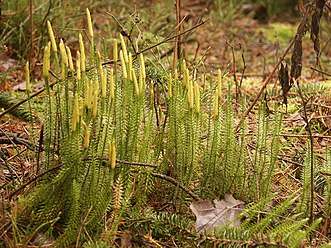Spinulum annotinum
Spinulum annotinum, synonym Lycopodium annotinum, known as interrupted club-moss,[1] or stiff clubmoss[2], is a species of clubmoss native to forests of the colder parts of North America (Greenland, St. Pierre & Miquelon, all 10 provinces and all 3 territories of Canada, Alaska, and mountains of the contiguous United States),[3] as well as Asia (China, Russia, Japan, Korea, Nepal, Assam),[4] and most of Europe.[5] The genus Spinulum is accepted in the Pteridophyte Phylogeny Group classification of 2016 (PPG I),[6] but not in other classifications, which submerge the genus in Lycopodium.[7]
| Spinulum annotinum | |
|---|---|
 | |
| Scientific classification | |
| Kingdom: | Plantae |
| Clade: | Tracheophytes |
| Clade: | Lycophytes |
| Class: | Lycopodiopsida |
| Order: | Lycopodiales |
| Family: | Lycopodiaceae |
| Genus: | Spinulum |
| Species: | S. annotinum |
| Binomial name | |
| Spinulum annotinum (L.) A.Haines | |
| Synonyms | |
| |
Spinulum annotinum is a common and widespread club-moss spreading by means of horizontal stems running along the surface of the ground. It is usually unbranched or sparingly branched, each branch containing a cone at the top. Leaves have minute teeth on their edges.[8][9][10]

References
- "BSBI List 2007". Botanical Society of Britain and Ireland. Archived from the original (xls) on 2015-01-25. Retrieved 2014-10-17.
- "Lycopodium annotinum". Natural Resources Conservation Service PLANTS Database. USDA. Retrieved 24 June 2015.
- "Spinulum annotinum". State-level distribution map from the North American Plant Atlas (NAPA). Biota of North America Program (BONAP). 2014.
- Zhang, Li-Bing; Iwatsuki, Kunio. "Lycopodium annotinum". Flora of China. 2 – via eFloras.org, Missouri Botanical Garden, St. Louis, MO & Harvard University Herbaria, Cambridge, MA.
- Altervista Flora Italiana, Licopodio gineprino, Lycopodium annotinum L. includes photos and European distribution map
- PPG I (2016). "A community-derived classification for extant lycophytes and ferns". Journal of Systematics and Evolution. 54 (6): 563–603. doi:10.1111/jse.12229.
- Christenhusz, Maarten J.M. & Chase, Mark W. (2014). "Trends and concepts in fern classification". Annals of Botany. 113 (9): 571–594. doi:10.1093/aob/mct299. PMC 3936591. PMID 24532607.
- Wagner Jr., Warren H.; Beitel, Joseph M. (1993). "Lycopodium annotinum". In Flora of North America Editorial Committee (ed.). Flora of North America North of Mexico (FNA). 2. New York and Oxford – via eFloras.org, Missouri Botanical Garden, St. Louis, MO & Harvard University Herbaria, Cambridge, MA.
- Aiken, S.G.; Dallwitz, M.J.; Consaul, L.L.; McJannet, C.L.; Boles, R.L.; Argus, G.W.; Gillett, J.M.; Scott, P.J.; Elven, R.; LeBlanc, M.C.; Gillespie, L.J.; Brysting, A.K.; Solstad, H.; Harris, J.G. (2011). Lycopodium annotinum L. subsp. alpestre (Hartm.) Á. Löve and D. Löve. Flora of the Canadian Arctic Archipelago. Ottawa: NRC Research Press, National Research Council of Canada.
- "Lycopodium annotinum L., Lycopode à rameaux annuels". Tela Botanica (in French).
External links
- Photo of herbarium specimen at Missouri Botanical Garden, collected on Mt. Adams in New Hampshire in 1889, neotype of Lycopodium annotinum
- Go Botany, New England Wildflower Society, Spinulum annotinum (L.) A. Haines bristly clubmoss, common interrupted-clubmoss] photos plus New England distribution map
- Michigan Flora, Spinulum annotinum (L.) A. Haines photos plus Michigan distribution map
- Digital Atlas of the Virginia Flora, Spinulum annotinum (L.) A. Haines photos plus Virginia distribution map
- Boreal Forest, Lycopodium annotinum Stiff Clubmoss description, photos, ecological information
- West Highland (Scotland) Flora, Interrupted Clubmoss, Lycopodium annotinum photos from near Skye in Scotland
